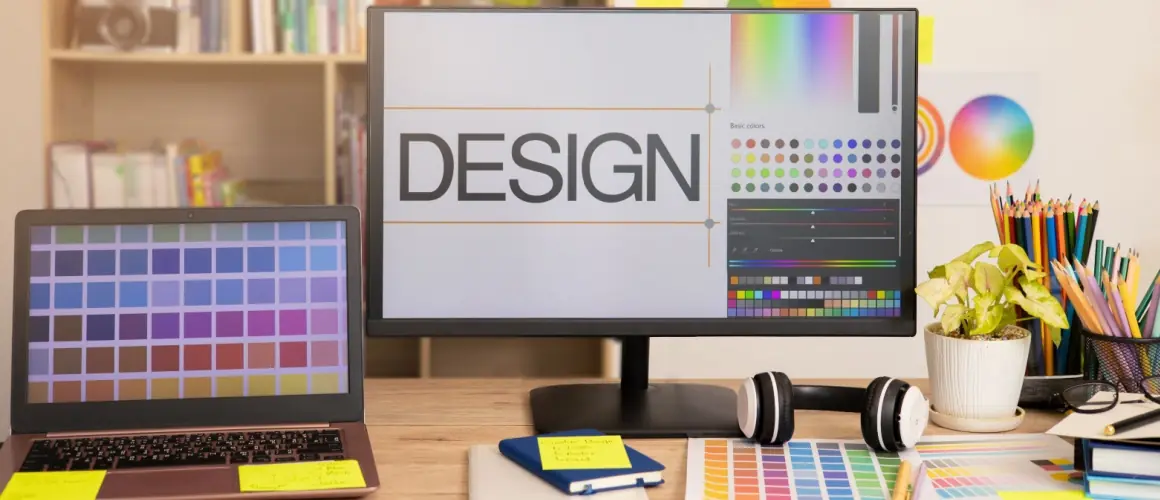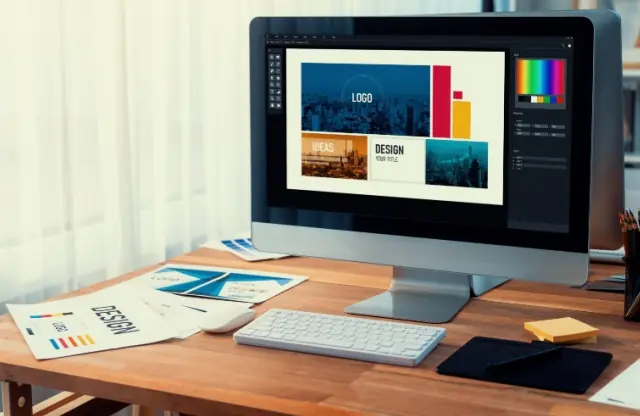
When it comes to making a memorable impression, “visual identity” is a term you’ll hear often. It is a powerful tool that helps define your brand, representing it through various visual elements. Whether it’s your logo, color scheme, typography, or imagery, each visual element works together to create a cohesive look that identifies your brand. This unified appearance is crucial because it represents your brand and tells the story of your product or service. A well-crafted one doesn’t only catch the eye. It communicates who you are and what you stand for, making it an essential part of any brand strategy.
Creating a strong one involves more than good design. It’s about consistency and making sure every visual element aligns with your brand’s values and message. This helps build trust and recognition among your audience. In this article, we’ll explore various aspects of visual identity. We’ll cover why it’s important for any brand, the difference between it and brand identity, and the key elements. Additionally, we’ll discuss how to create and maintain a strong visual identity and share best practices to help you represent your brand effectively. Join us as we delve into the visual side of branding and discover how it can elevate your business.

What is Visual Identity?
Visual identity is the set of visual elements that show what a brand is all about. It includes logo designs, color schemes, typography, imagery, and layout. Together, these elements create a cohesive and recognizable brand image. It is a powerful tool in brand strategy. It helps define your brand and communicate its values and personality to the target audience. By consistently using these visual elements across different platforms, a brand can create a memorable presence. This presence resonates with potential customers and enhances brand equity.
The visual identity of a brand does more than just look good. It plays a crucial role in brand positioning. It helps potential customers quickly identify your brand and set it apart from competitors. For example, unique package design and consistent use of colors and fonts can make a product or service stand out on the shelves and in ads. A well-crafted one also builds trust and credibility. It reinforces the brand image and fosters an emotional connection with the audience.
To create a strong identity, you should work with a skilled graphic designer. This designer should understand your brand’s values and target audience. This teamwork ensures that every visual element fits the brand’s strategy and effectively communicates its message.

Importance of Visual Identity for Any Brand
Visual identity is crucial for any brand. It helps in creating a consistent and recognizable image that customers can relate to and trust. Here are some key reasons why visual identity is important:
1. Enhances Brand Recognition
A strong visual identity makes your brand easily recognizable. When people see your logo designs or color schemes, they should instantly identify your brand. Consistent use of visual elements across all platforms helps in building this recognition.
2. Builds Trust and Credibility
A well-designed one boosts trust and credibility. Potential customers who see a professional and consistent one, are more likely to trust your brand. This credibility is essential for establishing long-term relationships with your audience.
3. Supports Brand Strategy
Visual identity plays a key role in your brand strategy. It helps define your brand’s values and personality, making it easier to communicate your brand’s message to your target audience. This alignment ensures that all marketing materials and communications are cohesive and effective.
4. Differentiates from Competitors
A unique visual identity sets your brand apart from competitors. Using distinct colors, typography, and package design can make your products stand out on the shelves and in advertisements. This differentiation is vital in a crowded marketplace.
5. Increases Brand Equity
A consistent and appealing identity enhances brand equity. It creates a strong brand image that resonates with customers, increasing their loyalty and preference for your brand. Over time, this loyalty translates into higher brand equity and value.
6. Improves Marketing and Content Creation
A clear visual identity makes content creation and marketing more efficient. With predefined visual guidelines, your team can produce marketing materials that are consistent and aligned with your brand’s image. This consistency is key to reinforcing your brand message across all channels.
In summary, a strong visual identity is a powerful tool for any brand. It enhances recognition, builds trust, supports your brand strategy, differentiates you from competitors, increases brand equity, and improves marketing efforts. Ensuring a cohesive and consistent one is essential for long-term success.

Visual Identity vs. Brand Identity
Understanding the difference between visual identity and brand identity is crucial for effective branding. Both are important aspects of branding, but they serve different purposes and include different elements.
Visual Identity
Visual identity refers to the visual components that represent and distinguish a brand. This includes elements like logos, color schemes, typography, and imagery. These components create a cohesive and recognizable image for the brand. Visual identity is a subset of brand identity. It focuses on how a brand is visually represented across platforms and materials. This involves graphic design elements that show the brand’s personality and values visually.
Brand Identity
Brand identity is the broader concept that encompasses all the elements that make the brand what it is. It includes visual identity but also covers aspects like brand values, mission, messaging, and brand strategy. Brand identity is the personality of the brand and how it wants to be perceived by the target audience. It involves both visual and non-visual elements. These are elements such as the brand’s tone of voice, storytelling, and customer interactions.
Key Differences
Scope: Visual identity is about visual elements, while brand identity encompasses everything that makes the brand, including visual and non-visual elements.
Components: Visual identity includes logos, colors, typography, and imagery. Brand identity includes these and more, such as mission, values, messaging, and positioning.
Purpose: Visual identity aims to create a consistent and recognizable image. Brand identity aims to build a comprehensive brand experience that connects with the audience on many levels.
How They Work Together
Visual identity and brand identity are interconnected. A strong one supports and reinforces the brand identity. It does this by expressing the brand’s values and personality visually. Consistency in visual elements helps tell the brand story. This makes the brand more memorable. Together, they create a cohesive brand experience. This resonates with the target audience and builds brand equity.
Simply put, visual identity focuses on the brand’s visual representation. Brand identity includes both visual and non-visual aspects. Understanding and using both effectively is key for a strong brand strategy.

Elements of a Good Visual Identity
Creating a strong visual identity is essential for any brand. It ensures that the brand is recognizable, memorable, and consistent across all platforms. Here are key elements that contribute to a successful one:
Logos
A logo is a critical component of visual identity. It is the brand’s “face,” instantly recognizable by potential customers. Effective logos are simple, memorable, and versatile, able to be used across various platforms and sizes. A well-designed logo conveys the brand’s personality and values, forming a central part of its graphic design strategy.
Brand Colors
Brand colors are another fundamental aspect. The color palette chosen for a brand communicates its values and personality. Consistently using brand colors across all marketing materials and platforms makes the brand easily identifiable. It also helps build an emotional connection with the target audience.
Typography
Typography involves selecting fonts that align with the brand’s personality and values. The right fonts can make a brand appear elegant, modern, or fun. Choose legible and readable typefaces that work well across different mediums. Consistent typography enhances the brand’s content’s visual style and readability.
Imagery and Photography Style
Imagery and photography style are vital for conveying a brand’s story and values visually. High-quality, consistent images help to establish an emotional connection with the audience. Reflect the brand’s personality in the selected style. Use it consistently across all visual materials to reinforce the brand’s identity.
Graphics, Illustrations, and Icons
Graphics, illustrations, and icons show a brand’s features and services quickly. They simplify complex ideas and enhance brand recognition. Custom icons and illustrations tailored to the brand add to its unique visual language. All this makes the brand more memorable.
Product and Package Design
Product and package design are crucial touchpoints for any product-based brand. Packaging not only protects the product but also serves as a brand ambassador. A well-designed package captures the brand’s essence, tells its story, and appeals to the target audience. It is often the first interaction potential customers have with the brand, making it a pivotal element.
By focusing on these elements, a brand can create a cohesive and compelling visual identity that resonates with its target audience and supports its brand strategy.

Best Practices for a Strong Visual Identity
Creating a strong visual identity involves strategic planning and execution. Here are some best practices to ensure your visual elements effectively communicate your brand story and resonate with your target audience:
Let a Professional Designer Shape Your Visual Identity
Hiring a professional designer can significantly enhance your visual identity. Designers create cohesive and impactful visual elements that align with your brand’s values and message. They apply visual design aspects like logos and color palettes consistently across all platforms. This ensures a unified brand experience.
Use Visuals to Communicate
Visual elements are powerful tools for communicating your brand story. Use graphics, illustrations, and images to convey complex ideas quickly and effectively. Using consistent visual design across marketing materials establishes brand recognition and makes your brand more memorable to your target audience.
Align Product Design with Brand Visuals
Your product and package design should reflect your brand’s visual identity. This consistency communicates your brand’s values and personality, enhancing the customer experience. Well-designed packaging attracts potential customers and reinforces your brand’s image and message.
By following these best practices, you can create a strong identity that communicates your brand story effectively and resonates with your target audience, building lasting connections and brand loyalty.

How to Maintain a Consistent Visual Identity
Maintaining a consistent visual identity is crucial for brand recognition and trust. It involves clear guidelines, dedicated management, and accessible resources for your team. Here are key steps to ensure yours remains cohesive across all platforms.
Create a Documented Visual Identity Guide
A documented visual identity guide serves as a rulebook for your brand’s visual elements. It includes guidelines on logos, color schemes, typography, and imagery. This guide ensures that all visual materials align with the brand’s standards. Providing detailed instructions helps maintain consistency and reinforces the brand’s identity across all channels.
Assign a Visual Identity Manager
This person oversees the application of visual guidelines and ensures that all design elements follow the established rules. They review and approve materials, provide feedback, and maintain the integrity of the brand’s identity. Having a dedicated manager helps avoid inconsistencies and ensures cohesion.
Make a Visual Identity Reference File for Your Team
A visual identity reference file is a collection of approved visual elements. It includes logos, fonts, color codes, and templates. This resource allows designers and marketers to access the correct elements quickly. By using these pre-approved assets, your team can produce materials that align with the brand’s visual standards. This ensures consistency in every project.
By following these steps, you can maintain a consistent visual identity that effectively communicates your brand’s story and values. This consistency builds trust with your target audience and enhances brand recognition.
Indian Companies with a Strong Visual Identity
Indian companies excel in creating strong visual identities that effectively communicate their brand stories and connect with their target audience. Here are some notable examples:
Tata Group
The Tata Group’s identity revolves around its core values of trust, ethics, and social responsibility. The distinctive blue and red “T” logo symbolizes the company’s commitment to innovation and progress, helping to establish Tata as a respected brand globally.
Royal Enfield
Royal Enfield’s identity is rooted in its heritage and history. The winged “R” emblem represents the brand’s legacy in the motorcycle industry. This emblem, prominently used in advertising and packaging, highlights the brand’s focus on tradition and craftsmanship.
Titan
Titan’s identity is centered on design and innovation. The stylized “T” logo in a distinctive font reflects elegance and sophistication. This logo, consistently used across all products, positions Titan as a premium brand in the watch and jewelry industry.
Paperboat
Paperboat’s identity is based on nostalgia and childhood memories. Colorful packaging illustrations of playful scenes like kite-flying evoke a sense of creativity and playfulness, making the brand memorable and relatable.
IndiGo
IndiGo’s identity focuses on simplicity and efficiency. The stylized “i” logo represents speed and agility, consistently applied across all branding and advertising materials, reinforcing IndiGo’s image as a reliable low-cost airline.
These brands demonstrate how a strong visual identity can effectively communicate a brand’s story, values, and personality, creating a lasting connection with the audience.

Reach Out to Synapse for Impactful Visual Design
A strong visual identity is crucial for any brand, enhancing recognition, building trust, and supporting brand strategy. Effective visual elements, such as logos, color schemes, and typography, must align with the brand’s values to communicate your brand story effectively. At Synapse, one of India’s oldest creative agencies, we specialize in creating compelling visual identities. Our expertise in graphic design, brand voice, and visual asset management ensures your brand stands out. One of our best examples is our logo redesign project for PIA & GDIZ, two Integrated Industrial Platforms (IIPs) developed by Arise IIP in West Africa.
Explore our work on the Showcase page or visit the Services page for more information. If you have questions, call us at 1800 121 5955 (India), email us at contact@synapse.co, or use our Contact form. You can also WhatsApp us your contact details, and our visual design experts will get in touch.







